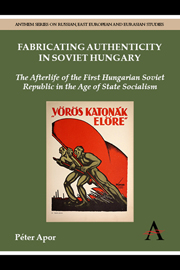 Fabricating Authenticity in Soviet Hungary
Fabricating Authenticity in Soviet Hungary Book contents
- Frontmatter
- Contents
- Acknowledgements
- List of Illustrations
- List of Abbreviations
- Introduction
- Chapter 1 Prefiguration: The First Hungarian Soviet Republic and the Rákosi Dictatorship before 1956
- Chapter 2 Resurrection: The Emergence of 1919 and the Counterrevolution after 1956
- Chapter 3 Lives: 1919 in the Postwar Trials of War Criminals
- Chapter 4 Funeral: The Birth of the Pantheon of the Labour Movement in Budapest
- Chapter 5 Narration: History, Fiction and Proof in the Representation of the First Hungarian Soviet Republic, 1959–65
- Epilogue The Agitators and the Armoured Train
- Index
Chapter 1 - Prefiguration: The First Hungarian Soviet Republic and the Rákosi Dictatorship before 1956
Published online by Cambridge University Press: 05 April 2014
- Frontmatter
- Contents
- Acknowledgements
- List of Illustrations
- List of Abbreviations
- Introduction
- Chapter 1 Prefiguration: The First Hungarian Soviet Republic and the Rákosi Dictatorship before 1956
- Chapter 2 Resurrection: The Emergence of 1919 and the Counterrevolution after 1956
- Chapter 3 Lives: 1919 in the Postwar Trials of War Criminals
- Chapter 4 Funeral: The Birth of the Pantheon of the Labour Movement in Budapest
- Chapter 5 Narration: History, Fiction and Proof in the Representation of the First Hungarian Soviet Republic, 1959–65
- Epilogue The Agitators and the Armoured Train
- Index
Summary
On 21 March 1949, the Hungarian Federation of Freedom Fighters – a Communist partisan organization which allegedly consisted of wartime anti-Nazi resistance fighters, but which was mostly a fiction to convince Hungarians of the existence of an indigenous Communist resistance movement – organized a bicycle and motorbike race around blocks of flats in Budapest. The competition was part of a set of ceremonies commemorating the proclamation of the First Hungarian Soviet Republic on 21 March 1919. The director of the Institute for Party History, László Réti, justified its appropriateness as follows: ‘We have to take care of, and improve the spirit of, fighting for freedom, a spirit the representatives of which construct with one hand, while with the other hand – if they must – they defend, even with weapons, their own constructions. The best illustrations for fostering this spirit of freedom fight are provided by the heroes who were fighting for the Soviet Republic.’ Of all the commemorative events of the 30th anniversary, this bicycle race was probably the most curious.
Postwar Hungarian Communists wanted to construct the history of 1919 as an instance of a ‘usable past’ and establish the First Hungarian Soviet Republic as the praefiguratio of their own regime. In this way they could benefit from previous Soviet exercises in historical typology, which identified episodes in the past as models for contemporary political action.
- Type
- Chapter
- Information
- Fabricating Authenticity in Soviet HungaryThe Afterlife of the First Hungarian Soviet Republic in the Age of State Socialism, pp. 27 - 60Publisher: Anthem PressPrint publication year: 2014


